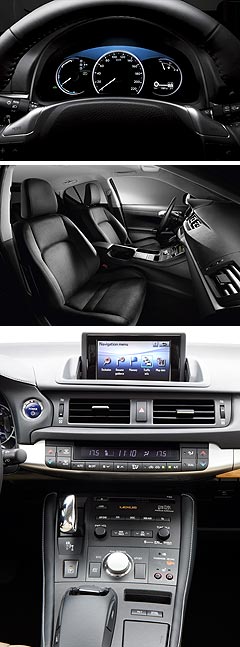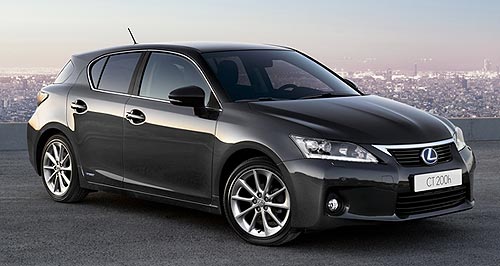Future models - Lexus - CT - 200hLexus plans quicker CTMore to come: Lexus has investigated options for increasing the CT200h's power output over that of the standard, Prius-based drivetrain. Higher-performance version of the CT200h hybrid on the cards4 Oct 2010 STAND BY for a higher-performance version of the all-new Lexus CT200h, if comments by the car’s chief engineer are any guide. Osamu Sadakata, who was the chief engineer for the first Lexus hybrid, the RX400h, from 2003 and for all Lexus hybrids since 2006, revealed Lexus has studied a range of future powertrain options for its dedicated-hybrid CT. Due on sale here in the first quarter of 2011 after being previewed at the Sydney motor show on October 15, the sub-$50,000 CT will be released with a variation of the 1.8-litre VVT-i Atkinson Cycle four-cylinder petrol engine that powers Toyota’s petrol-electric Prius. Like the Prius, the CT’s petrol engine produces 73kW and its electric motor offers up to 60kW, with a switchable four-mode drive system that includes an all-electric mode for up to 2km of zero-emissions driving plus a ‘Sport’ mode that increases electric motor output from 500 to 650 volts for extra acceleration.  However, the CT’s claimed 0-100km acceleration time of 10.3 seconds will not match the upstream versions of its most closely priced premium small-car rivals, including the BMW 1 Series, Audi A3, Mercedes B-class, Mini Cooper, Volvo C30, Citroen DS3 and Alfa Romeo’s upcoming Giulietta. However, the CT’s claimed 0-100km acceleration time of 10.3 seconds will not match the upstream versions of its most closely priced premium small-car rivals, including the BMW 1 Series, Audi A3, Mercedes B-class, Mini Cooper, Volvo C30, Citroen DS3 and Alfa Romeo’s upcoming Giulietta.That could change according to Mr Sadakata, who ruled out a non-hybrid version of the CT but said Lexus has studied more powerful petrol-electric drive systems by adapting both a larger petrol engine and plug-in hybrid technology. Asked at last week’s global launch whether Lexus planned to enter production with either powertrain option in the CT200h, Mr Sadakata said that the larger-displacement 2.5-litre petrol-electric drive system that is expected to power Toyota’s next-generation Camry Hybrid fits into the CT engine bay, but indicated a plug-in version was his preferred option to increase performance. “If my company allows me to, I will build a more powerful CT,” he told GoAuto in Paris. “I want (a) more powerful CT200, 300 or 400h. “We have studied this, but I can’t say when we will produce it. Of course we have studied it. We have studied many things, but it’s not always the case that they materialise. We need to justify it. “We are comfortable with what the CT is. (But) if people say we need more power in this car, that makes it easier to justify the development of a more powerful version. “We are studying a plug-in version, but I can’t say when it will come.” Toyota is currently undertaking a global trial of 600 Prius Plug-In vehicles, including a handful in Australia, with a view to releasing it in 2012 with lithium-ion battery technology – rather than the nickel metal hydride batteries that currently power the Prius and CT200h. Mr Sadakata said a plug-in, lithium-ion battery version of the CT200h could offer both more performance and efficiency than the current model. Such a model could draw its battery technology from Tesla Motors, in which Toyota has invested and with which Toyota has developed an all-electric version of the RAV4 that will debut at the Los Angeles motor show in November. A higher-performance plug-in CT200h could also come with a more advanced version of the paddleshift gearshift system that is absent on the CT for all markets except Japan. Mr Sadakata said the Japan-only paddleshift system, which adds a selectable six-step function to the car’s CVT automatic transmission, were a “gimmick” that would not be appropriate for “connoisseur drivers” in markets like Europe and Australia, because the Atkinson Cycle engine did not offer enough engine braking to make them effective. Instead, he indicated that the use of super-capacitors in concert with more compact, more efficient and more powerful lithium-ion battery technology could deliver more performance, matched with an effective stepped CVT paddleshift system. Lexus Australia chief executive Tony Cramb defended the 1.8-litre CT hybrid’s performance and pointed out its unrivalled environmental credentials in the luxury small-car class, but admitted the brand’s smallest model ever is no sportscar. “CT is a great vehicle for its intended audience and it certainly raises the bar in the compact luxury segment,” he said. “We believe it’s a knockout blow in terms of the driving experience, and environmental performance. “We’re not trying to convince you this is a performance car because it’s not, but the CT will be faster to 100km/h than the (discontinued) Audi A3 1.9-litre turbo-diesel and it will use two-thirds the amount of fuel. It’s also quicker than a Volvo C30 DRIVe and the entire naturally aspirated Mercedes-Benz B-class range. “It’s well ahead of our competitors in terms of CO2, NOx and particulate emissions, and it will be one of the top three vehicles listed in the federal government’s Green Vehicle Guide. “Obviously it will be the highest rated luxury vehicle by miles, the nearest vehicle being our own Lexus RX450h hybrid in 13th place. “To ensure that we communicate the benefits and the outstanding nature of this vehicle effectively, our marketing will focus on the fact that CT is a great luxury hatch, it’s dynamic, it’s well-specified and it just happens to be a hybrid. “At the end of the day, it’s the driving experience and the ownership experience, and not the powerplant under the bonnet that really matters. “All I ask is that you look at this car with open eyes and give it a chance. Look at what it means to the category, consumers and the industry as a whole. It is a completely unique vehicle that has been designed with one goal and to achieve this goal we’ve leveraged the best of breed in powertrains, engineering, suppliers and thinking to deliver a vehicle that’s fun and frugal. “Most importantly, we’ve delivered a vehicle which is worthy of the Lexus badge, so we’re confident in our plans for CT and we believe we will engage customers who want a spritely, efficient C-car with the spec and features of a larger luxury car.” Like the Prius Plug-In and a range of next-generation hybrid models from Toyota, redesigned versions of the GS450h and LS600h are also likely to move to lithium-ion battery technology. While the IS350 will join the facelifted IS medium sedan range on sale in Australia from later this month and the CT200h is due for local release early next year, expect the next-generation GS large sedan to emerge as the next all-new model from Lexus, followed by redesigned versions of the five-year-old IS and, later, the flagship LS limousine. If Japanese reports prove correct, the next IS line-up will not only comprise a hybrid version but could spawn Toyota’s first hybrid sports coupe, while the limited-production LFA super-coupe’s carbon-fibre chassis could form the basis of a plug-in hybrid supercar to match the likes of Porsche’s recently green-lighted 918 Spyder plug-in performance king.  Read more16th of September 2010  Full details: Lexus CT200h hybrid laid bareNo power boost for Lexus CT over Prius hybrid, but loads of prestige and panache16th of September 2010  Paris show: Lexus up its M3 ante with IS F upgradeFacelifted Lexus IS F images and details emerge a month ahead of its Oz launch12th of August 2010  First small Lexus promises best-in-class dynamicsSydney show debut for CT200h on the cards as Lexus promises sporty handlingAll future models Alfa Romeo Alfa Romeo Abarth Abarth Audi Audi Aston Martin Aston Martin BMW BMW Bentley Bentley Chrysler Chrysler Chevrolet Chevrolet Dodge Dodge Citroen Citroen Ferrari Ferrari DS DS Ford Ford Fiat Fiat FPV FPV Foton Foton Haval Haval Great Wall Great Wall Honda Honda Holden Holden Hyundai Hyundai HSV HSV Isuzu Isuzu Infiniti Infiniti Jeep Jeep Jaguar Jaguar Lamborghini Lamborghini Kia Kia Lexus Lexus Land Rover Land Rover Mazda Mazda Maserati Maserati Mercedes-Benz Mercedes-Benz McLaren McLaren Mini Mini Nissan Nissan Mitsubishi Mitsubishi Peugeot Peugeot Opel Opel Proton Proton Porsche Porsche Renault Renault Ram Ram Saab Saab Rolls-Royce Rolls-Royce Smart Smart Skoda Skoda Subaru Subaru SsangYong SsangYong Tesla Tesla Suzuki Suzuki Toyota Toyota Volvo VolvoCT pricing
Motor industry news |
Click to shareLexus modelsResearch Lexus All future models Alfa Romeo Alfa Romeo Abarth Abarth Audi Audi Aston Martin Aston Martin BMW BMW Bentley Bentley Chrysler Chrysler Chevrolet Chevrolet Dodge Dodge Citroen Citroen Ferrari Ferrari DS DS Ford Ford Fiat Fiat FPV FPV Foton Foton Haval Haval Great Wall Great Wall Honda Honda Holden Holden Hyundai Hyundai HSV HSV Isuzu Isuzu Infiniti Infiniti Jeep Jeep Jaguar Jaguar Lamborghini Lamborghini Kia Kia Lexus Lexus Land Rover Land Rover Mazda Mazda Maserati Maserati Mercedes-Benz Mercedes-Benz McLaren McLaren Mini Mini Nissan Nissan Mitsubishi Mitsubishi Peugeot Peugeot Opel Opel Proton Proton Porsche Porsche Renault Renault Ram Ram Saab Saab Rolls-Royce Rolls-Royce Smart Smart Skoda Skoda Subaru Subaru SsangYong SsangYong Tesla Tesla Suzuki Suzuki Toyota Toyota Volvo VolvoCT pricing
Motor industry news |















Facebook Twitter Instagram